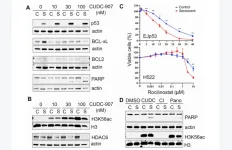Described in a paper published today in Development, the researchers found that having a third copy of the gene Dyrk1a and at least three other genes were responsible for these changes taking place in development – called craniofacial dysmorphology – which involve shortened back-to-front length and widened diameter of the head.
Affecting 1 in 800 live births, Down Syndrome is known as a ‘gene dosage disorder’ – meaning that it involves changes in the number of copies of a gene. People with Down Syndrome have three copies of chromosome 21 instead of two. Having three copies of certain genes on this chromosome causes aspects typical of Down Syndrome, but it’s not yet known which genes are responsible.
Using genetic engineering, teams led by Victor Tybulewicz of the Francis Crick Institute and Elizabeth Fisher of University College London created mouse strains with duplications of three regions on mouse chromosome 16, which mimics having a third chromosome 21. The mice show lots of traits associated with Down Syndrome, including changes in the shape of the face and skull.
Previous research has linked a gene called Dyrk1a to aspects of Down Syndrome, so the researchers wanted to test how it impacted craniofacial dysmorphology.
Now working with Jeremy Green's group at King’s College London, they showed that mice with an extra copy of Dyrk1a had a reduced number of cells in the bones at the front of the skull and in the face. Also, cartilaginous joints at the base of the skull called synchondroses were abnormally fused together. These effects were partly reversed when the third copy of Dyrk1a was removed, showing that three copies of Dyrk1a are necessary to cause these changes in the skull.
The researchers believe that having a third copy of Dyrk1a hinders the growth of neural crest cells that are needed to form the bones at the front of the skull.
In addition to Dyrk1a, the research showed that three other genes also contribute to the changes in the skull, but more research is needed to confirm their identity.
Victor Tybulewicz, Group Leader of the Down Syndrome Laboratory at the Crick, who worked with first author Yushi Redhead, said: “There’s currently limited treatments for the aspects of Down Syndrome which have a negative impact on people’s health, like congenital heart conditions and cognitive impairment, so it’s essential we work out which genes are important.
“Understanding the genetics involved in the development of the head and face gives us clues to other aspects of Down Syndrome like heart conditions. Because Dyrk1a is so key for craniofacial dysmorphology, it's highly likely that it’s involved in other changes in Down Syndrome too.”
Researchers at King’s College London used shape-measuring tools to map the changing skull shape of the mice. These showed changes in skull shape that were remarkably similar to those seen in people with Down Syndrome.
Jeremy Green, Professor of Developmental Biology at King’s College London, said: “With the help of great collaborators at the University of Calgary in Canada and a medical imaging software group here at King’s, we were able to apply both quite traditional and some very novel methods for comparing complex anatomical shapes. These were sensitive enough to pick up differences even at foetal stages. This helped us pin down not only the locations of genes that cause Down Syndrome but also get clues as to how those genes cause the differences that they do.”
This research forms part of an ongoing project to understand the genetics of Down Syndrome. The researchers will next aim to identify the genes involved in heart defects and in cognitive impairment, bringing us a step closer to understanding how to develop targeted treatments for aspects of Down Syndrome which impact health.
-ENDS-
For further information, contact: press@crick.ac.uk or +44 (0)20 3796 5252
Notes to Editors
Reference: Redhead, Y. et al. (2023). Craniofacial dysmorphology in Down Syndrome is caused by increased dosage of Dyrk1a and at least three other genes. Development. https://doi.org/10.1242/dev.201077
The Francis Crick Institute is a biomedical discovery institute dedicated to understanding the fundamental biology underlying health and disease. Its work is helping to understand why disease develops and to translate discoveries into new ways to prevent, diagnose and treat illnesses such as cancer, heart disease, stroke, infections, and neurodegenerative diseases.
An independent organisation, its founding partners are the Medical Research Council (MRC), Cancer Research UK, Wellcome, UCL (University College London), Imperial College London and King’s College London.
The Crick was formed in 2015, and in 2016 it moved into a brand new state-of-the-art building in central London which brings together 1500 scientists and support staff working collaboratively across disciplines, making it the biggest biomedical research facility under a single roof in Europe.
http://crick.ac.uk/
King’s College London’s Faculty of Dentistry, Oral & Craniofacial Sciences is one of the foremost dental schools in the world. Recently rated in the top ten in the world in dentistry by the QS World University Rankings 2023, the Faculty aims to maximise impact on health and wellbeing by integrating excellence across four areas:
Education / teaching
World-class science
Clinical approaches
Patient care
The Faculty’s mission is to understand disease, enhance health and restore function. Their vision is to be world leading in dental, oral and craniofacial education, research and clinical care.
The Faculty’s international reputation attracts students and staff from across the globe. The largest dental academic centre in the UK, they teach over 700 undergraduate students, 140 graduate taught students, 300 distance learning students and 110 graduate research students. The Faculty is shaped by a diverse student and staff population which adds strength to its standing.
The faculty has over 85 academic staff and is organised into three research priority areas:
Development, Regeneration, Repair & Tissue Engineering
Immunity, Infection & Host-Microbe Interactions
Clinical, Translational & Population Health.
The research areas complement the teaching and clinical service initiatives.
As well as excellent research facilities, the Faculty has internationally recognised education programmes. With highly skilled teachers and supervisors, there are exceptional facilities, including access to over 300,000 patients each year across world-famous hospitals, Guy’s & St Thomas’, and King’s College Hospitals for hands-on clinical training. They are one of the most comprehensive dental academic health science centres in Europe.
Further details of the faculty may be found on its website: www.kcl.ac.uk/dentistry
Press contact details:
Laura Shepherd
Communications Manager
Faculty of Dentistry, Oral & Craniofacial Sciences
King’s College London
Laura.shepherd@kcl.ac.uk
About UCL – London’s Global University
UCL is a diverse global community of world-class academics, students, industry links, external partners, and alumni. Our powerful collective of individuals and institutions work together to explore new possibilities.
Since 1826, we have championed independent thought by attracting and nurturing the world's best minds. Our community of more than 50,000 students from 150 countries and over 16,000 staff pursues academic excellence, breaks boundaries and makes a positive impact on real world problems.
We are consistently ranked among the top 10 universities in the world and are one of only a handful of institutions rated as having the strongest academic reputation and the broadest research impact.
We have a progressive and integrated approach to our teaching and research – championing innovation, creativity and cross-disciplinary working. We teach our students how to think, not what to think, and see them as partners, collaborators and contributors.
For almost 200 years, we are proud to have opened higher education to students from a wide range of backgrounds and to change the way we create and share knowledge.
We were the first in England to welcome women to university education and that courageous attitude and disruptive spirit is still alive today. We are UCL.
www.ucl.ac.uk | Follow @uclnews on Twitter | Read news at www.ucl.ac.uk/news/ | Listen to UCL podcasts on SoundCloud | Find out what’s on at UCL Minds
Press contact details:
Poppy Danby, UCL Media Relations. T: +44 (0)7733307596, E: p.danby@ucl.ac.uk
END




